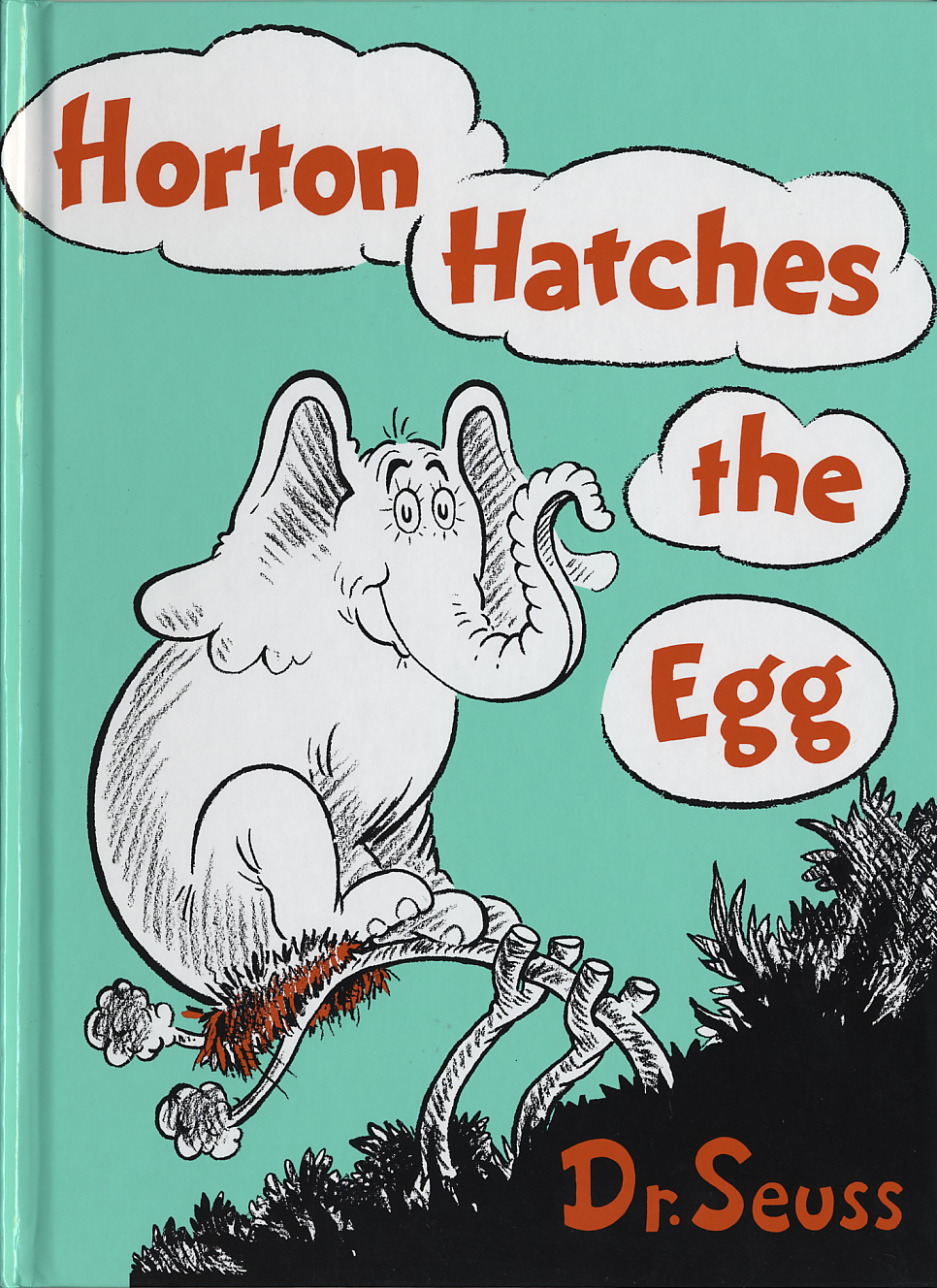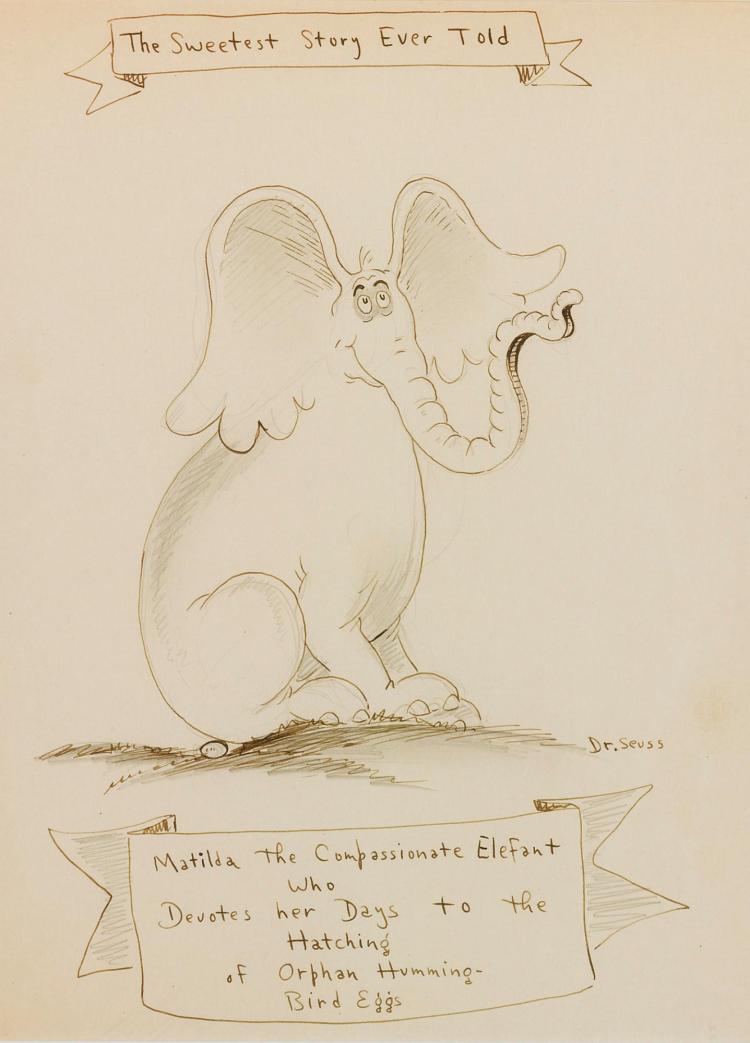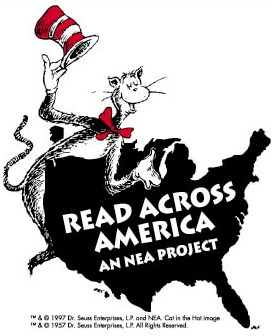Happy Birthday, Dr. Seuss! To celebrate the 113th anniversary of Theodor Seuss Geisel’s birth, here are two things Seussian.
1. The True Story of Horton Hatches the Egg
 When asked how he came up with the idea of Horton Hatches the Egg (1940), Seuss would often give an answer like this (from a September 1972 interview):
When asked how he came up with the idea of Horton Hatches the Egg (1940), Seuss would often give an answer like this (from a September 1972 interview):
Horton Hatches the Egg was a lucky accident. I was in my New York studio one day, sketching on transparent tracing paper, and I had the window open. The wind simply took a picture of an elephant that I’d drawn and put it on top of another sheet of paper that had a tree on it. All I had to do was to figure out what the elephant was doing in that tree. I’ve left my window open for 30 years since that, but nothing’s happened.
That’s a delightful story, but it’s not true. Not only do earlier accounts contradict it, but in a 1938 issue of Judge magazine, Seuss published “Matilda, the Elephant with a Mother Complex.” In that story, an elephant also hatches an egg – but it does not turn out happily. Matilda’s egg hatches, the bird sees her, and it flies off in terror. In contrast, Horton’s baby elephant-bird chooses him over its biological mother, Mayzie.
This past December, Southebys attempted to auction some original art of Matilda – though not precisely the art used in that Judge story. It seems to be an earlier version of the art, but it’s not clear how much earlier. Its provenance suggests it could be over a decade older.

The auction described the piece like this:
ESTIMATE: $30,000 – $40,000
DESCRIPTION: signed Dr.Seuss pen-and-ink drawing on paper 10 1/2 x 6 1/2 inches; 11 x 8 1/2 inches (267 x 165 mm; 279 x 216 mm) Executed circa 1938.
CATALOG NOTE: A delightful original drawing comprising the earliest known version of Dr Seuss’s beloved character Horton (here a femaile [sic] elephant, Matilda), looking very pleased with herself, seated on a small egg, with captions written on banners above and below the image.
The catalogue offers other information, some of it accurate and some of it less so. But let’s skip ahead to the provenance:
PROVENANCE: Given by Geisel to Harvey Poe, Jr (born in 1916) while the artist was vacationing in Brookline, Maine (Harvey Poe, Sr managed the Mountain Ash Inn & Cottages, where the artist stayed). Mr Poe believes it was given to him when he was about 9 (i.e. 1925) and while this is of course possible, it seems more likely the drawing was given to him well after Geisel’s return from Europe, probably soon after the similar design appeared in Judge magazine (April 1938).
Is the piece really from 1925? It could be. On June 23rd, Geisel graduated from Dartmouth, and two months later left for Oxford, England. He was in the U.S. for most of 1925, and not far from Brookline, Maine. In addition to New Hampshire (where Dartmouth is), Geisel was also in Springfield, Massachusetts (his hometown). Prior to then, he had been drawing cartoons for Dartmouth’s Jack-o-Lantern. Stylistically, however, this piece looks closer to his art from a decade later.
Priced at $30,000-$40,000, the original “Matilda” drawing failed to sell. To the best of my knowledge, it is still being held at Southebys. So, if you have that sort of cash lying around (I don’t!), try bidding on next time it goes up for auction.
2. Me, talking about Seuss, yesterday on The Joy Cardin Show.
I was on for the entire 8 o’clock hour of yesterday’s show. Did I have anything interesting to say? You be the judge. Listen here.
To continue your celebration of Seuss’s birthday, you may enjoy perusing other posts tagged Seuss. Here’s a selection:
- How Do We Stop the Trump on the Stump? The Truth Is in Seuss! (28 March 2016). From my ears to the American electorate. (Results of the warning were, um, mixed. At best.)
- Seuss on Film (2 March 2016). Includes four clips of Seuss: Unusual Occupations (1940), Making SNAFU (c. 1943), To Tell the Truth (1958), and footage from a New Zealand schoolroom (1964).
- No Seuss Better Than Faux Seuss (27 July 2015). On bad imitation Seuss verse, contrasted with good imitation – provided via audio of David Rakoff’s excellent “Samsa and Seuss.”
- Six Spots of Seuss News (2 Mar. 2015). On What Pet Should I Get?, Elana Kagan’s citation of One fish two fish red fish blue fish (1960) in a 2015 Supreme Court decision written by Justice Elena Kagan, Dr. Seuss advertising art from 1936, and a Dr. Seuss rap quiz!
- Was the Cat in the Hat Black? (22 June 2014). An excerpt from an essay, in which I explore Dr. Seuss’s racial imagination. This is also the title for my next book, due from Oxford UP in July of this year (2017). You can see the cover and read more about it here.
- Oh, the Quotations You’ll Forge! (2 Mar. 2014). Seuss’s pithy verse is very quotable. Unfortunately, people have a habit of attributing things to him that he never said. This post exposes some fake Seuss, and gives you plenty of quotations that he actually did say.
- Happy birthday to Dr. Seuss! A guest post by Charles D. Cohen (2 Mar. 2013). Birthday reflections from Seussologist Charles Cohen (The Seuss, the Whole Seuss, and Nothing But the Seuss). Quotes some original verse by Seuss, including “Pentellic Bilge for Bennett Cerf’s Birthday” (1940).
- How to Mispronounce “Dr. Seuss” (6 Feb. 2013). Also: how to pronounce “Dr. Seuss.”
- I Am the Lorax. I Speak for the Theeds? (3 Mar. 2012). Some thoughts on The Lorax film and its attendant advertising.
- Dr. Seuss: children’s books “have a greater potential for good or evil, than any other form of literature on earth.” (1 Mar. 2012). A 1960 essay by Seuss on writing for children.
- Dr. Seuss on “conditioned laughter,” racist humor, and why adults are “obsolete children” (16 Jan. 2012). A 1952 essay by Seuss on humor.
- Seussology (15 Jan. 2012): On my graduate-level “Dr. Seuss” course.
- Oh, the Thinks That He Thought! Some of Seuss’s Lesser-Known Works (2 Mar. 2011): My post for Dr. Seuss’s birthday in 2011.
- You’re a Mean One, Mr. Grinch (20 Dec. 2010): 15 versions of the song.
- Corporate Seuss; or, Oh, the Things You Can Sell! (21 Aug. 2010). Ted Geisel was first famous for advertising, not children’s books.
From time to time, I get asked to talk about Dr. Seuss:
- Joshua Barajas, “8 Things You Didn’t Know About Dr. Seuss,” PBS News Hour blog, 22 July 2015.
- “New Window into Dr. Seuss’s genius” (26 Feb. 2014). John Wilkens’ article in the San Diego Tribune discusses new Seuss material that his widow, Audrey, donated to the Dr. Seuss Papers at UCSD.
- “Dr. Seuss: Mini-Biography.” A&E Biography (2013). Time: 4 minutes.
- All Things Considered. Lynn Neary, “‘The Bippolo Seed’ : The ‘Lost’ Dr. Seuss Stories” (13 Apr. 2011): audio & transcript. Charles Cohen & I talk about the new book of “lost” Seuss stories (edited by Charles). Time: 3 mins, 30 secs.
- Diane Rehm Show. Dr. Seuss’s How the Grinch Stole Christmas! (22 Dec. 2010): audio & transcript. Reverend Derrick Harkins, Maria Salvadore, and I talk with Diane Rehm about the Grinch. Time: 1 hour.
- Morning Edition. Lynn Neary, “Fifty Years of The Cat in the Hat” (1 Mar. 2007): audio & transcript. Anita Silvey and I talk with Lynn Neary about the Cat in the Hat. Time: 7 mins, 20 secs.
- Talk of the Nation. Steve Inskeep, “Celebrating the 100th Birthday of Dr. Seuss: A New Book Looks Back on the Life of Theodor Geisel” (10 Feb. 2004): audio. I was a bit nervous at the beginning (I believe it was my first time on live national radio), but after the first few minutes I seem to settle into it well enough. Time: 1 hour.
| Though the website design impedes its utility, Random House’s Seussville‘s author section includes a bio. and timeline I wrote – the former heavily influenced by Judith and Neil Morgan’s excellent Dr. Seuss & Mr. Geisel. (If you read only one book about Dr. Seuss, the Morgans’ bio is the one I’d recommend.) Happy Read Across America Day!*
*Each year on or near March 2nd (the birthday of Theodor Seuss Geisel, a.k.a. Dr. Seuss), the National Education Association sponsors Read Across America, designed to promote literacy. This year, it’s being celebrated on Wednesday, March 2nd. Read more about it at the NEA’s website. |
 |

Rockinlibrarian